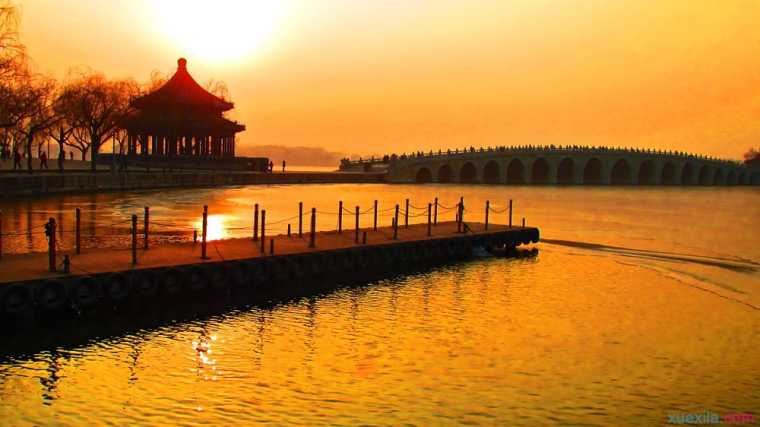颐和园的英语简介(中英)
导读:颐和园,北京市古代皇家园林,前身为清漪园,坐落在北京西郊,距城区十五公里,占地约二百九十公顷,与圆明园毗邻。它是以昆明湖、万寿山为基址,以杭州西湖为蓝本,汲取江南园林的设计手法而建成的一座大型山水园林,也是保存最完整的一座皇家行宫御苑,被誉为“皇家园林博物馆”,也是国家重点景点。

希望同学们在外游玩的同时,也增加课外英语知识,提高英文水平。
颐和园简介
颐和园主景区由万寿山、昆明湖组成,全园占地2.9平方公里,水面约占四分之三。园内现存各式宫殿、园林古建7万平方米,并以珍贵的文物藏品闻名于世,是第一批全国重点文物保护单位。
颐和园前身为清漪园,始建于清朝乾隆十五年(1750),咸丰十年(1860)被英法联军烧毁。光绪十二年(1886),清廷挪用海军经费等款项开始重建,并于两年后取用今名,作为慈禧太后的颐养之所。一九零零年又遭八国联军破坏,一九零二年修复。中华人民共和国成立后,几经修缮,颐和园陆续复建了四大部洲、苏州街、景明楼、澹宁堂、文昌院、耕织图等重要景区。
颐和园集传统造园艺术之大成,借景周围的山水环境,既有皇家园林恢弘富丽的气势,又充满了自然之趣,高度体现了中国园林“虽由人作,宛自天开”的造园准则。一九九八年十二月,颐和园被联合国教科文组织列入《世界遗产名录》,并予以如下评价:1)北京的颐和园是对中国风景园林造园艺术的一种杰出的展现,将人造景观与大自然和谐地融为一体;2)颐和园是中国的造园思想和实践的集中体现,而这种思想和实践对整个东方园林艺术文化形式的发展起了关键性的作用;3)以颐和园为代表的中国皇家园林是世界几大文明之一的有力象征。
The Summer Palace in Brief
The Summer Palace, dominated mainly by Longevity Hill and Kunming Lake, covers an area of 2.9 square kilometers, three quarters of which is under water. Its 70,000 square meters of building space features a variety of palaces, gardens and other ancient-style architectural structures. Well known for its large and priceless collection of cultural relics, it was among the first group of historical and cultural heritage sites in China to be placed under special state protection.
The Summer Palace, originally named Qingyi Yuan or the Garden of Clear Ripples, was first constructed in 1750. It was razed to the ground by the Anglo-French Allied Forces in 1860. The Government of the Qing Dynasty started to rebuild it in 1886 with funds that it had misappropriated from the Imperial Navy and other sources. Renamed two years later as Yihe Yuan or the Garden of Health and Harmony, it was supposed to serve as a summer resort for the Empress Dowager Cixi. Known also as the Summer Palace, it was ravaged by the Allied Forces of the Eight Powers that invaded China in 1900. The damage was repaired in 1902. Since the founding of the People’s Republic of China, the Summer Palace has undergone several major renovations. Its major attractions such as the Four Great Regions, Suzhou Street, the Pavilion of Bright Scenery, the Hall of Serenity, the Wenchang Galleries and the Plowing and Weaving Scenery Area have been successively restored.
The Summer Palace is a monument to classical Chinese architecture, in terms of both garden design and construction. Borrowing scenes from surrounding landscapes, it radiates not only the grandeur of an imperial garden but also the beauty of nature in a seamless combination that best illustrates the guiding principle of traditional Chinese garden design: “The works of men should match the works of Heaven”. In December 1998, UNESCO included the Summer Palace on its World Heritage List with the following comments: 1) The Summer Palace in Beijing is an outstanding expression of the creative art of Chinese landscape garden design, incorporating the works of humankind and nature in a harmonious whole; 2) The Summer Palace epitomizes the philosophy and practice of Chinese garden design, which played a key role in the development of this cultural form throughout the east; 3) The imperial Chinese garden, illustrated by the Summer Palace, is a potent symbol of one of the major world civilizations.
颐和园的英语简介相关文章:
1.关于上海旅游英语介绍
2.假期旅游英语对话
3.旅游英语书籍推荐
4.出国旅游必须懂的英语词语和句子
5.出国旅游基本英语大全